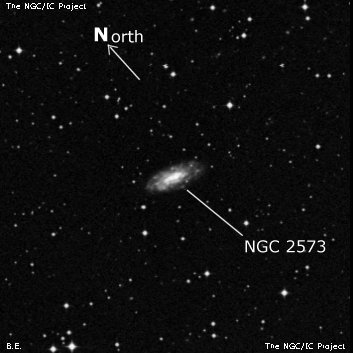
John Herschel discovered NGC 2573 = h3176 on 29 Mar 1837 and recorded "Neb Polarissima Australis. Faint, round, gradually a little brighter in the middle, 25" across. Situated nearly halfway between a star of 10th magnitude south of it, and a small triangle of stars 11th, 13th and 13th mag. north." This is the closest galaxy to the south celestial pole. In 1919 Robert Innes reported he was unsuccessful in searching for it under the best condistions with the 9-inch Grubb refractor at the Union Observatory in Johannesburg. The RNGC positions are in error for NGC 2573, 2573A and 2573B.
600/800mm - 24" (4/5/08 - Magellan Observatory, Australia): NGC 2573 is known as "Polarissima Australis" and is located only 40' from the south celestial pole. At 260x it appeared fairly faint, moderately large, very elongated 7:2, ~1.6'x0.45'. Contains a very small, bright nucleus with much fainter extensions. A mag 10.6/11.2 pair at 7" separation was picked up 13' NNE. This galaxy was brighter than I expected based on descriptions I've read.
Notes by Steve Gottlieb